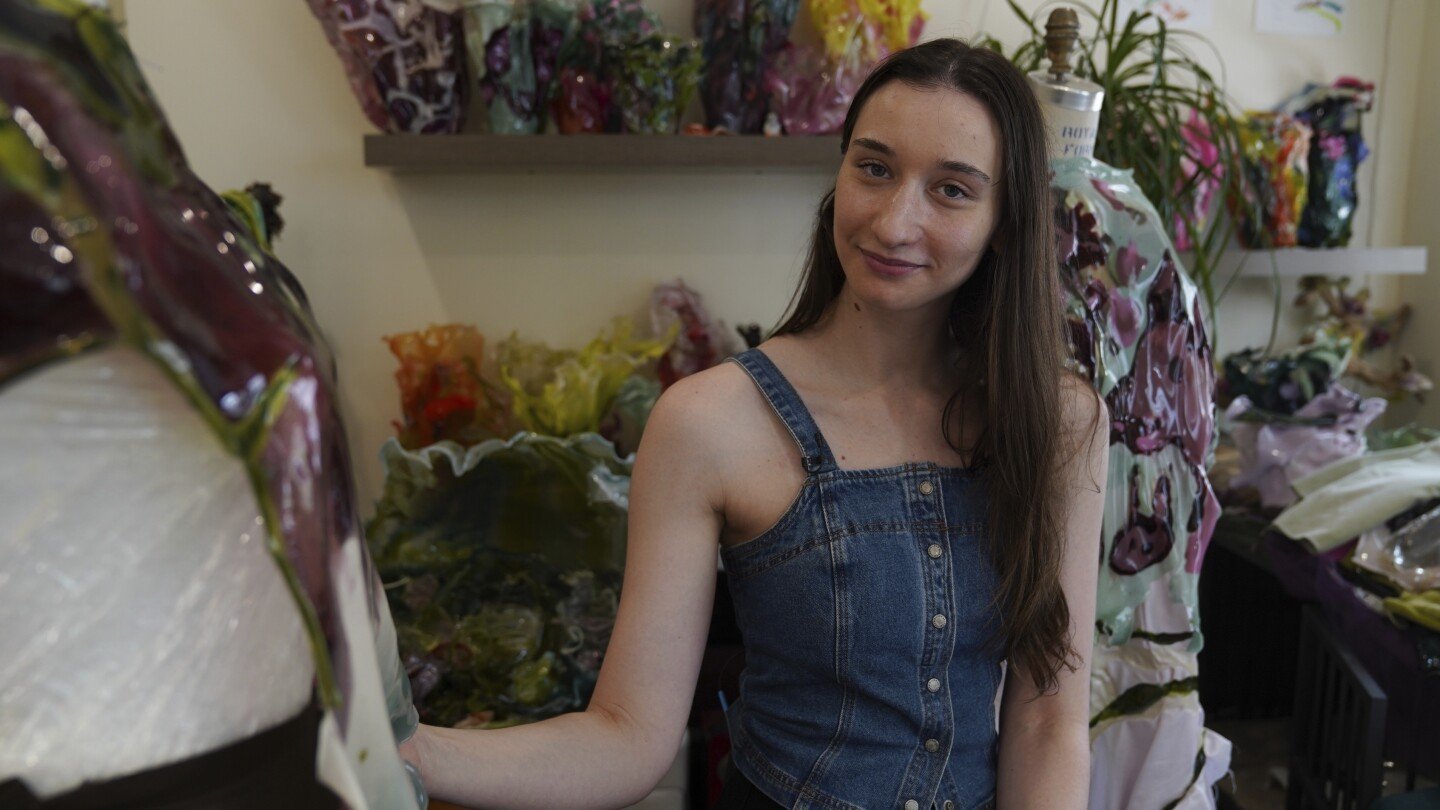Lifestyle
Tania León and Maria Teresa Kumar among Carnegie’s 2025 ‘Great Immigrants, Great Americans’ honorees

Tania León, the noted composer and conductor who also cofounded Dance Theatre of Harlem, never planned on emigrating to the United States. She wanted to move to Paris.
When León received the opportunity to leave Cuba on a resettlement flight to Miami in 1967, she took it, thinking she would eventually end up settling in France where she would join the Conservatoire de Paris and become a concert pianist. Instead, she moved to New York and within months met Arthur Mitchell, the New York City Ballet dancer who achieved international acclaim and integrated the art form as its first Black star.
“You cannot predict the future,” León told The Associated Press in an interview. “By a chance moment, I bumped into the man that in a way changed my life… and then he spoke to me about the creation of something that he had in mind that later on became the Dance Theatre of Harlem and then I was involved in all of this.”
“All of this” – her composing, her conducting of the New York Philharmonic, her work on Broadway – led to León being honored Thursday by the Carnegie Corp. of New York as part of its 20th class of Great Immigrants, Great Americans.
“I am just overwhelmed with this latest recognition about what I have been able to contribute because I didn’t do it with the purpose of gaining awards and things like that,” Leon said. “I think that one has to convey the gratitude for the opportunities that I have received since I arrived.”
The 20 members of this year’s class of Great Immigrants, Great Americans represent a wide range of immigration journeys, but they share a desire to give back to the country that has become their home. What the Carnegie initiative celebrates is also how American immigrants have improved their country.
“For 20 years, our Great Immigrants public awareness initiative has been a reminder that many of the most influential figures in our country have been distinguished naturalized citizens, like our founder Andrew Carnegie, born in Scotland,” Carnegie President Dame Louise Richardson — also a naturalized American citizen, born in Ireland — said in a statement. “The U.S. is a nation of immigrants and our ongoing support of nonpartisan organizations that help establish legal pathways for citizenship continues to enrich the very fabric of American life.”
Nobel Prize winner Simon Johnson honored
British-born Massachusetts Institute of Technology Sloan School of Management professor Simon Johnson, another honoree from this year’s Great Immigrants class, said immigrants have also enriched the American economy.
“If people come to the United States, with very few exceptions, they come because they want to work,” said Johnson, who won the 2024 Nobel memorial prize in economics with two other American immigrants, Turkish-born Daron Acemoglu and fellow Brit, James Robinson. “They want to work hard. They want to be productive. They want to improve their lives and have better futures for their kids… That dynamism we have is a big part of what’s going well in many parts of the U.S.”
Johnson said the immigrant perspective helped the team on its prize-winning study, which studied countries and found that freer, open societies are more likely to prosper. And the support that academia in the United States provides is also helpful.
“American universities have incredible opportunities — lots of time for research, really interesting teaching, great students — it’s an amazing combination,” he said. “I’ve been incredibly lucky because it’s a space that allows you to work hard and get lucky.”
This year’s honorees are named as immigration becomes an increasingly contentious issue. President Donald Trump’s administration is looking to add $150 billion to support his mass deportation agenda, which has drawn protests, as U.S. Immigration and Customs Enforcement looks to arrest 3,000 people in the country illegally each day.
Voto Latino CEO Maria Teresa Kumar selected
Maria Teresa Kumar, president and CEO of the civic engagement nonprofit Voto Latino and another of Carnegie’s 2024 honorees, said the anti-immigration sentiment is painful on so many levels.
“A multicultural America is our secret superpower,” said Kumar, who emigrated from Colombia with her family when she was four years old. “There are plenty of people in foreign interference that try to divide our country around race and status because they know that multiculturally, when human capital is what’s going to determine the 21st Century, we are truly unstoppable… It’s that diversity and value of thought that makes us really strong. And what’s happening right now seems like we are impeding our progress because we’re not seeing the bigger picture.”
Kumar and Voto Latino have been outspoken with their criticism of the Trump administration and have directed some of their resources toward keeping immigrants informed of their rights and offering advice to deal with ICE raids.
Geri Mannion, managing director of Carnegie’s Strengthening U.S. Democracy Program, which oversees the Great Immigrants, Great American awards and other civic participation initiatives, said they will continue handing out the awards because immigrants help the United States on multiple levels.
Carnegie is also marking the 20th anniversary with a free comic book that celebrates the lives of previous honorees, including Rock and Roll Hall of Famer David Byrne, Peabody Award-winning comedian Mo Amer, and Jim Lee, the chief creative officer of the DC comics universe. The comic will also be used by the National Council of Teachers of English to develop lesson plans and other educational resources.
“In other countries, you could be there three generations, but you might be seen still seen as the other,” she said. “In the U.S., you’re considered American the moment you take that oath. And nobody thinks twice about it.”
——-
Full list of 2025 class of Great Immigrants, Great Americans
Carnegie Corp. of New York’s 2025 Class of Great Immigrants, Great Americans is: Calendly founder and CEO, Tope Awotona, originally from Nigeria; Moungi Bawendi, Massachusetts Institute of Technology professor of chemistry (France); Helen M. Blau, Director of the Baxter Laboratory for Stem Cell Biology and Stanford University professor (England); Roger Cohen, New York Times journalist and Paris Bureau Chief (England); Akiko Iwasaki, Yale University School of Medicine professor of Immunobiology, Dermatology, and Epidemiology (Japan); comedian/actor Maz Jobrani (Iran); MIT Sloan School of Management entrepreneurship professor Simon Johnson (England); Kynisca CEO Michele Kang, owner of the Washington Spirit (South Korea); Flex-N-Gate CEO Shahid Khan (Pakistan); AAPI Equity Alliance executive director Manjusha P. Kulkarni (India); Voto Latino CEO María Teresa Kumar (Colombia); composer/conductor Tania León (Cuba); Northwell Health vice president Sandra Leisa Lindsay (Jamaica); Rockefeller University professor and Howard Hughes Medical Institute investigator Luciano Marraffini (Argentina); Yale professor of astronomy and physics Priyamvada Natarajan (India); comedian/artist Kareem Rahma (Egypt); California U.S. Rep. Raúl Ruiz (Mexico); Manoochehr Sadeghi, grand master of the santur, the Persian dulcimer (Iran); former prima ballerina Yuan Yuan Tan, of the San Francisco Ballet (China); and Avi Wigderson, mathematics professor at the Institute for Advanced Study (Israel).
_____
Associated Press coverage of philanthropy and nonprofits receives support through the AP’s collaboration with The Conversation US, with funding from Lilly Endowment Inc. The AP is solely responsible for this content. For all of AP’s philanthropy coverage, visit https://apnews.com/hub/philanthropy.
Lifestyle
Man charged after kilt-wearing attacker smashes case holding Scotland’s Stone of Destiny

LONDON (AP) — A man from Australia has been charged with “malicious mischief” for allegedly smashing a glass case holding the Stone of Destiny, an ancient symbol of Scottish nationhood.
Arnaud Harixcalde Logan, 35, appeared at Perth Sheriff Court on Monday to face the charge, which is similar to vandalism.
Logan, whose address was given as Sydney, wasn’t asked to enter a plea and was ordered detained until a hearing next week.
Police said that they were called to a “disturbance” at Perth Museum in central Scotland on Saturday, after reports of a kilt-wearing man attempting to smash the case containing the royal rock.
The 335-pound (150-kilogram) sandstone block is also known as the Stone of Scone (Skoon) — and was used in the crowning ceremonies of medieval Scottish monarchs at Scone Abbey, near Perth. It was stolen by England’s King Edward I in the 13th century and taken to Westminster Abbey in London, where it was installed under the seat of the coronation chair.
It has been used in coronations at the abbey ever since — first of English and then of British monarchs The English and Scottish crowns were united under one monarch in the 17th century.
The stone’s presence in London long irked Scottish nationalists. In 1950, it was stolen from Westminster Abbey by four Glasgow university students, but was returned in time for the coronation of Queen Elizabeth II in 1953.
It was given back to Scotland in 1996, 700 years after its seizure, and displayed in Edinburgh Castle, with the understanding that it would return to England for use in future coronations. Sensitivities around the stone meant that it had to be moved to London in secrecy and amid tight security for the coronation of King Charles III in 2023.
Last year it was put on display at the newly renovated Perth Museum where, according to the building’s website, there are “a range of 24/7 security measures in place at the Museum to protect this precious object.”
Culture Perth and Kinross, which oversees the museum, said the stone wasn’t damaged in the incident.
Lifestyle
These flavor-packed pork burgers were inspired by Indian street food

These flavor-packed burgers are a spin on a spiced pork sausage from Goa in southern India, based on the garlicky, European-style chouriço introduced by Portuguese settlers. To combat the humidity of the region and prolong the shelf life of the sausage, the meat is heavily salted and flavored with a mixture of spices and tangy vinegar.
Goan sausage is ubiquitous in southern India, where you can find it sold at street food carts and high-end restaurants alike, sometimes baked into a bun or minced and stuffed between layers of fried naan.
In this recipe from our cookbook “ Milk Street 365: The All-Purpose Cookbook for Every Day of the Year,” we take inspiration from those burger-like sandwiches, using a combination of grated garlic, garam masala, cumin, paprika and cayenne to give the all-pork patties deep, complex flavor and a rusty hue. Grating the garlic ensures it melts into the meat without any distracting bits. Instead of naan, we use classic hamburger buns.
Egg and panko bread crumbs help the patties keep their shape. Don’t undermix the pork mixture; be sure to combine it well so the breadcrumbs and seasonings are evenly distributed.
These burgers are especially delicious topped with yogurt, torn fresh mint leaves and thin slices of cucumber or tomato.
Start to finish: 35 minutes
Servings: 4
Ingredients:
⅔ cup panko breadcrumbs
¼ cup plain whole-milk yogurt, plus more to serve
5 teaspoons garam masala
5 teaspoons sweet paprika
1 tablespoon ground cumin
½ teaspoon cayenne pepper
2 large egg yolks
2 medium garlic cloves, finely grated
Kosher salt and ground black pepper
1 pound ground pork
2 tablespoons grapeseed or other neutral oil
4 hamburger buns, toasted
Directions:
In a large bowl, combine the panko, yogurt, garam masala, paprika, cumin, cayenne, egg yolks, garlic, ¾ teaspoon salt, ½ teaspoon pepper and ¼ cup water. Using a fork, mash the mixture into a smooth paste. Add the pork and mix with your hands until evenly combined. Form into 4 patties, each about 4 inches in diameter, place on a large plate and refrigerate for 15 minutes.
In a 12-inch nonstick skillet over medium, heat the oil until barely smoking. Add the burgers and cook until well browned, 7 to 8 minutes. Flip, reduce to medium-low and continue to cook until the patties are well browned on the second sides and the centers reach 160°F, another 5 to 7 minutes. Transfer to a clean plate, tent with foil and let rest for 5 minutes. Serve on the buns with additional yogurt on the side.
EDITOR’S NOTE: For more recipes, go to Christopher Kimball’s Milk Street at 177milkstreet.com/ap
Lifestyle
Fashion designers experiment with natural supplies called biomaterials

NEW YORK (AP) — At her kitchen stove, fashion designer Caroline Zimbalist looks like an alchemist at work as she stirs a pot full of corn starch and a thickener made from seaweed. The peppermint-scented mixture glitters as she carefully pours it into silicone molds of hearts and leaves.
When the material hardens, Zimbalist will stitch it into unique, made-to-order dresses that she sells on her website. She hopes her designs, which have been worn by celebrities including Chappell Roan, will put a spotlight on materials that aren’t sourced from planet-polluting fossil fuels, such as oil.
“It’s almost like a vessel to show the world,” she said.
Other small-scale designers are testing out tapioca, gelatin and other kitchen-shelf ingredients. Meanwhile, big names such as Adidas and Hermes have experimented with mushroom leather, while the Lycra brand is incorporating a new largely corn-based material into stretch fabric. Some experts are skeptical that these textiles — commonly referred to as biomaterials — will go mainstream, but designers such as Zimbalist hope their experiments will set an example for larger brands to follow.
Over 60% of clothing comes from petroleum-based synthetics like polyester, according to Textile Exchange, a nonprofit that promotes sustainable fashion. Manufacturing those materials creates emissions. Synthetic garments can also shed microplastics during washing. And as fast-fashion brands pump out new clothes for customers who expect new designs every few weeks, many garments end up in landfills.
A piece by fashion designer Caroline Zimbalist is displayed on Friday, June 6, 2025, in the Queens borough of New York. (AP Photo/Mary Conlon)
Zimbalist’s designs gained attention in 2024 when Roan wore one on “The Tonight Show.” The New York-based designer has since dressed stars such as comedian Atsuko Okatsuka and actors Anna Lore and Reneé Rapp. She takes commissions for custom clothing pieces, which cost between $150 and $1,200, via her website, which notes her “unique recipe of biodegradable and natural materials.”
As to whether her approach could be reproduced at a larger scale, Zimbalist says her materials could most practically be used to replace plastic hardware such as buttons and zippers. She acknowledges they can be sticky if not dried correctly, stinky if not treated and melty if exposed to extreme heat.
“Even incorporating it in small ways to start would be really strong,” she said.
Why biomaterials are hard to find
Fossil-fuel derived fabrics are ubiquitous because they’re cheap and made from plentiful raw materials, said Dale Rogers, an Arizona State University professor who studies supply chains.
Many clothes are also made of materials that come from plants or animals such as cotton, silk, wool and cashmere. But some have environmental impacts. Cotton uses a lot of water. Sheep and goats burp out methane.
Some biomaterials have gotten closer to widespread use. Mycelium leather, made from mushrooms, has been used to create luxury shoes, accessories and handbags by brands such as Stella McCartney, Lululemon, Adidas and Hermes.
Still, Rogers said he’s not convinced there’s enough demand for alternative materials to overcome companies’ aversion to the higher costs of producing them at a large scale.
“Honestly, in the end, cost drives almost all decisions,” he said.
Wrinkles in aiming for sustainability
Getting larger companies to use alternative materials depends on whether they will pay more for a fabric that matches their values, said Jon Veldhouse, the CEO of Qore LLC.
His company makes a product called Qira that replaces about 70% of the fossil-derived components of elastic synthetic fabrics with a corn-based material. The Lycra Company, which sells its stretchy material to major brands, initially expects to incorporate Qira in around 25 percent of its Spandex business, said Lycra chief brand and innovation officer Steve Stewart. But that option will be more expensive, and they haven’t yet announced any takers.
It can also be hard to measure the sustainability of farming practices that go into producing raw materials for new fabrics. Cargill is Qore’s partner and corn supplier, and it gets its grain from farmers in the vicinity of their processing plant. Veldhouse said many already plant cover crops or reduce tilling to lower environmental impact, but he couldn’t provide data on how many use those approaches.
Sarah Needham, a senior director at Textile Exchange, said it’s great to see a large organization such as Lycra making its production systems more sustainable. But she also stressed the industry needs to reduce its overreliance on virgin materials, perhaps considering agricultural waste as a source of fabric.
The role of experimental designers
Needham said experimental designers are often the ones coming up with those alternatives to virgin materials and building appetite for new approaches.
But small designers might not have the resources to test the biodegradability of their materials, which often do involve processing, even if it’s by hand, said Ramani Narayan, an engineering professor at Michigan State University.
“If I take something — like seaweed or whatever it is — and I apply a process to it, then I can no longer call it natural,” he said.
Zimbalist, the New York designer, acknowledges that her materials aren’t ready to replace conventional fabrics and that her work is more of “a piece that leads to larger conversations.”
Rogers, of Arizona State, thinks the fashion industry is a long way from meaningful change, but that “it’s incredibly valuable” for artists and specialty manufacturers to try new materials.
“What they’re doing is likely to have long-term benefit, maybe even after their lifetimes,” he added.
___
Follow Melina Walling on X @MelinaWalling and Bluesky @melinawalling.bsky.social.
Follow Kiki Sideris on X @KikiSideris.
___
The Associated Press’ climate and environmental coverage receives financial support from multiple private foundations. AP is solely responsible for all content. Find AP’s standards for working with philanthropies, a list of supporters and funded coverage areas at AP.org.
-

 Europe5 days ago
Europe5 days agoBondi and Hegseth might be messing up — but they’re doing what Trump picked them to do
-

 Sports3 days ago
Sports3 days agoBill Ackman: Swift backlash after billionaire’s pro debut
-

 Lifestyle4 days ago
Lifestyle4 days agoSebeiba festival in Algeria carries on ancient tradition
-

 Europe3 days ago
Europe3 days agoGerman tourist found alive 12 days after she was lost in the Australian Outback
-

 Africa5 days ago
Africa5 days agoGreece blocks asylum claims after surge in migrant arrivals
-

 Lifestyle4 days ago
Lifestyle4 days agoHealthy workday snacks include a smart mix of energy-boosters
-

 Lifestyle3 days ago
Lifestyle3 days agoOne Tech Tip: All the ways to unsubscribe, after ‘click-to-cancel’ was blocked
-

 Sports3 days ago
Sports3 days agoMarc and Álex Márquez: Two brothers, one title dream – MotoGP’s high stakes sibling rivalry




